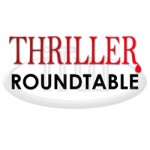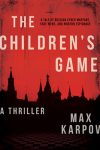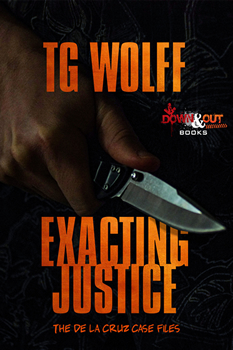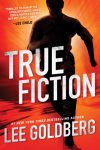

April 9 – 15: “How do you create the antagonist?”
 Hero or anti-hero? Protagonist or antagonist? If the hero is only as good as his or her enemy, how do you create the antagonist? This week we tap into the creative powers of ITW Members Don Helin, Keith Dixon, Max Karpov, Linda Sands, Robert Black Whitehill, T. G. Wolff, Peter Beck, Kelli Stanley, Lee Goldberg, Humphrey Hawksley and Jacob Stone. Scroll down to the “comments” section to follow along!
Hero or anti-hero? Protagonist or antagonist? If the hero is only as good as his or her enemy, how do you create the antagonist? This week we tap into the creative powers of ITW Members Don Helin, Keith Dixon, Max Karpov, Linda Sands, Robert Black Whitehill, T. G. Wolff, Peter Beck, Kelli Stanley, Lee Goldberg, Humphrey Hawksley and Jacob Stone. Scroll down to the “comments” section to follow along!
 Max Karpov is the author of the new Russia thriller The Children’s Game. Karpov is the nom de plume of James Lilliefors, who also writes the Bowers and Hunter mystery series (The Psalmist, The Tempest), featuring Methodist pastor Luke Bowers and homicide detective (and agnostic) Amy Hunter. Karpov/Lilliefors is a native of the Washington, D.C. area. He currently lives with his wife in South Florida.
Max Karpov is the author of the new Russia thriller The Children’s Game. Karpov is the nom de plume of James Lilliefors, who also writes the Bowers and Hunter mystery series (The Psalmist, The Tempest), featuring Methodist pastor Luke Bowers and homicide detective (and agnostic) Amy Hunter. Karpov/Lilliefors is a native of the Washington, D.C. area. He currently lives with his wife in South Florida.
 Robert Blake Whitehill is a screenwriter and author of the award-winning, critically acclaimed, bestselling Ben Blackshaw Thrillers set on Smith Island in the Chesapeake Bay. He has written highly rated true crime TV for Discovery, including The New Detectives, as well as UXO (Unexploded Ordnance), a feature script that won Whitehill a fellowship from the Alfred P. Sloan Foundation.
Robert Blake Whitehill is a screenwriter and author of the award-winning, critically acclaimed, bestselling Ben Blackshaw Thrillers set on Smith Island in the Chesapeake Bay. He has written highly rated true crime TV for Discovery, including The New Detectives, as well as UXO (Unexploded Ordnance), a feature script that won Whitehill a fellowship from the Alfred P. Sloan Foundation.
 TG Wolff writes thrillers and mysteries that play within the gray area between good and bad, right and wrong. Cause and effect drive the stories, drawing from 20+ years’ experience in Civil Engineering, where “cause” is more often a symptom of a bigger, more challenging problem. Diverse characters mirror the complexities of real life and real people, balanced with a healthy dose of entertainment. TG Wolff holds a Master’s Degree in Civil Engineering and is a member of Mystery Writers of America and Sisters in Crime.
TG Wolff writes thrillers and mysteries that play within the gray area between good and bad, right and wrong. Cause and effect drive the stories, drawing from 20+ years’ experience in Civil Engineering, where “cause” is more often a symptom of a bigger, more challenging problem. Diverse characters mirror the complexities of real life and real people, balanced with a healthy dose of entertainment. TG Wolff holds a Master’s Degree in Civil Engineering and is a member of Mystery Writers of America and Sisters in Crime.
 Peter Beck studied Psychology, Philosophy and Economics in Bern, where he also gained a doctorate in Psychology. He did his military service as a cyclist in the Swiss Army and has a black belt in judo. Having done an MBA in Manchester, UK, he went on to become an executive board member of a large Swiss company and sat on several non-executive boards. Today he is his own boss and divides his time between writing the Tom Winter thrillers and supporting businesses in shaping their culture, organization and strategy. He is fluent in English. His thriller DAMNATION (2018) was originally published in German (Emons Verlag, 2013), has now been translated by Jamie Bulloch and is brought to you by Point Blank, an imprint of Oneworld, twice winner of the Man Booker Prize.
Peter Beck studied Psychology, Philosophy and Economics in Bern, where he also gained a doctorate in Psychology. He did his military service as a cyclist in the Swiss Army and has a black belt in judo. Having done an MBA in Manchester, UK, he went on to become an executive board member of a large Swiss company and sat on several non-executive boards. Today he is his own boss and divides his time between writing the Tom Winter thrillers and supporting businesses in shaping their culture, organization and strategy. He is fluent in English. His thriller DAMNATION (2018) was originally published in German (Emons Verlag, 2013), has now been translated by Jamie Bulloch and is brought to you by Point Blank, an imprint of Oneworld, twice winner of the Man Booker Prize.
 Lee Goldberg is a two-time Edgar & two-time Shamus Award nominee and the #1 New York Times bestselling author of over thirty novels, including the fifteen Monk mysteries and the internationally bestselling Fox & O’Hare books (The Heist, The Chase, The Job, The Scam, The Pursuit) co-written with Janet Evanovich. He’s also written and/or produced scores of TV shows, including Diagnosis Murder, SeaQuest, Monk, and The Glades. As an international television consultant, he has advised networks and studios in Canada, France, Germany, Spain, China, Sweden, and the Netherlands on the creation, writing and production of episodic television series. He recently founded, with author Joel Goldman, the publishing company Brash Books.
Lee Goldberg is a two-time Edgar & two-time Shamus Award nominee and the #1 New York Times bestselling author of over thirty novels, including the fifteen Monk mysteries and the internationally bestselling Fox & O’Hare books (The Heist, The Chase, The Job, The Scam, The Pursuit) co-written with Janet Evanovich. He’s also written and/or produced scores of TV shows, including Diagnosis Murder, SeaQuest, Monk, and The Glades. As an international television consultant, he has advised networks and studios in Canada, France, Germany, Spain, China, Sweden, and the Netherlands on the creation, writing and production of episodic television series. He recently founded, with author Joel Goldman, the publishing company Brash Books.
 Linda Sands is the award-winning author of five novels. Her short stories and essays have appeared in The Atlanta Journal-Constitution, The Walton Sun, Skirt! Magazine, Dogplotz, Moronic Ox, and a bunch of lit mags and anthologies. Most recent awards include Georgia Author of the Year for Mystery and two Silver Falchion Awards for Best Neo-noir and Best PI novel.
Linda Sands is the award-winning author of five novels. Her short stories and essays have appeared in The Atlanta Journal-Constitution, The Walton Sun, Skirt! Magazine, Dogplotz, Moronic Ox, and a bunch of lit mags and anthologies. Most recent awards include Georgia Author of the Year for Mystery and two Silver Falchion Awards for Best Neo-noir and Best PI novel.
 Don Helin is the author of five thrillers that draw from his military experience, including three tours in the Pentagon. His novel, Secret Assault, was selected as the Best Suspense/Thriller at the 2015 Indie Book Awards.
Don Helin is the author of five thrillers that draw from his military experience, including three tours in the Pentagon. His novel, Secret Assault, was selected as the Best Suspense/Thriller at the 2015 Indie Book Awards.
 Kelli Stanley is the Macavity Award-winning creator of the Miranda Corbie series (City of Dragons, City of Secrets, City of Ghosts), literary noir novels set in 1940 San Francisco and featuring “one of crime’s most arresting heroines” (Library Journal). She is also a Bruce Alexander Award and Golden Nugget Award winner, and a Shamus Award and Los Angeles Times Book Prize finalist. Kelli has also published numerous short stories and essays, holds a Master’s Degree in Classics, and prefers her bourbon neat.
Kelli Stanley is the Macavity Award-winning creator of the Miranda Corbie series (City of Dragons, City of Secrets, City of Ghosts), literary noir novels set in 1940 San Francisco and featuring “one of crime’s most arresting heroines” (Library Journal). She is also a Bruce Alexander Award and Golden Nugget Award winner, and a Shamus Award and Los Angeles Times Book Prize finalist. Kelli has also published numerous short stories and essays, holds a Master’s Degree in Classics, and prefers her bourbon neat.
 Keith Dixon was born in Yorkshire and grew up in the Midlands. He’s been writing since he was thirteen years old in a number of different genres: thriller, espionage, science fiction, literary. He’s the author of seven novels in the Sam Dyke Investigations series, three in the Paul Storey Thrillers series and two other non-crime works, as well as two collections of blog posts on the craft of writing. When he’s not writing he enjoys reading, learning the guitar, watching movies and binge-inhaling great TV series. He’s currently spending more time in France than is probably good for him.
Keith Dixon was born in Yorkshire and grew up in the Midlands. He’s been writing since he was thirteen years old in a number of different genres: thriller, espionage, science fiction, literary. He’s the author of seven novels in the Sam Dyke Investigations series, three in the Paul Storey Thrillers series and two other non-crime works, as well as two collections of blog posts on the craft of writing. When he’s not writing he enjoys reading, learning the guitar, watching movies and binge-inhaling great TV series. He’s currently spending more time in France than is probably good for him.
 Humphrey Hawksley is a journalist, author and commentator. His work as a BBC foreign correspondent has taken him to crises on every continent. He was expelled from Sri Lanka, opened the BBC’s television bureau in China, arrested in Serbia and initiated a global campaign against enslaved children in the chocolate industry. The campaign continues today. Hawksley is the author of the acclaimed ‘Future History’ series Dragon Strike, Dragon Fire and The Third World War that explores world conflict. MAN ON ICE is his fourth international political thriller. His work has appeared in the The New York Times, The Guardian, The Times, Financial Times, Yale Global and other publications. His university lectures include Columbia, Cambridge, University College London and the London Business School.
Humphrey Hawksley is a journalist, author and commentator. His work as a BBC foreign correspondent has taken him to crises on every continent. He was expelled from Sri Lanka, opened the BBC’s television bureau in China, arrested in Serbia and initiated a global campaign against enslaved children in the chocolate industry. The campaign continues today. Hawksley is the author of the acclaimed ‘Future History’ series Dragon Strike, Dragon Fire and The Third World War that explores world conflict. MAN ON ICE is his fourth international political thriller. His work has appeared in the The New York Times, The Guardian, The Times, Financial Times, Yale Global and other publications. His university lectures include Columbia, Cambridge, University College London and the London Business School.
 Jacob Stone is the pseudonym for award-winning author Dave Zeltserman. Dave’s crime and horror novels have been picked by NPR, the Washington Post, American Library Association, Booklist, and WBUR as best novels of the year, and his short mystery fiction has won a Shamus, Derringer and two Ellery Queen Readers Choice awards. Dave’s crime noir novel, Small Crimes, has been made into a major motion picture starring Nikolaj Coster-Waldau, Molly Parker, Gary Cole, Robert Forster, and Jacki Weaver, and will be premiering April 28th on Netflix. Several of his other books are currently in film development.
Jacob Stone is the pseudonym for award-winning author Dave Zeltserman. Dave’s crime and horror novels have been picked by NPR, the Washington Post, American Library Association, Booklist, and WBUR as best novels of the year, and his short mystery fiction has won a Shamus, Derringer and two Ellery Queen Readers Choice awards. Dave’s crime noir novel, Small Crimes, has been made into a major motion picture starring Nikolaj Coster-Waldau, Molly Parker, Gary Cole, Robert Forster, and Jacki Weaver, and will be premiering April 28th on Netflix. Several of his other books are currently in film development.
- LAST GIRL MISSING with K.L. Murphy - July 25, 2024
- CHILD OF DUST with Yigal Zur - July 25, 2024
- THE RAVENWOOD CONSPIRACY with Michael Siverling - July 19, 2024
